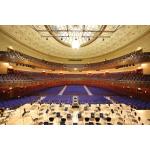Latest News
September 1, 2006
By Erin Hatfield
How do you test the effectiveness of something you cannot see? That was the task that faced engineers at Arup, an international consultancy firm. Arup provided engineering design services for the refurbishment of Sheffield City Hall, one of Sheffield’s key multi-use venues. The $22.3 million refurbishment project brought better patron access to seating and facilities, improved performer areas, new balconies and seating, and advanced conferencing and IT equipment to the venerable Hall.
Part of the overhaul is a new full fresh-air displacement ventilation system for the 2,300-seat Irwin Mitchell Oval Hall. Using CFD (computational fluid dynamics) and high-end visualization tools, Arup was able to see the new ventilation system’s output. This allowed Arup to analyze predicted comfort conditions and provided an opportunity to review possible improvements.
Creating an Automatic CFD Mesh
Arup’s design included the reuse and adaptation of many of the Hall’s existing work ventilation ducts and risers. A major part of Arup’s proposal was the construction of a new timber-framed floor plenum in which individual seat diffusers would be located.
To help understand the airflow systems, Arup created a CAD model of the Oval Hall in Rhino CAD based on 2D AutoCAD data and other information. The initial CAD model took three days to construct and was particularly complicated due to the curved seating and roof, and the high level of detail required for the pedestal, floor and step-mounted diffusers for the CFD mesh.
|
|
| Image courtesy of Arup. |
|
|
| Image courtesy of Arup. |
These EnSight visualizations from STAR-CD simulations show projected heat loads and ventilation temperature distribution in the recently refurbished Oval Hall in the UK’s Sheffield City Hall. Click images to enlarge.
Since the hall is symmetrical, the Rhino model was divided in half and imported as an STL file into Harpoon automatic CFD meshing software from CEI. Harpoon generated a hex-dominant mesh with prism layers applied where necessary to maintain a good wall function in the CFD analysis. The final model contained four million fluid cells.
“During the CFD analysis, we refined the CAD model and meshes several times,” says Darren Woolf, an associate with Arup. “Harpoon’s mesh generation speed allowed us to deal with these iterations with minimal time delay.”
The surfaces of the auditorium were initially modeled as resistive surfaces with fixed adjacent temperatures, since all surfaces were internal and not exposed to radiant heating or cooling from outside weather. Arup later adjusted this model to allow for radiant heat transfer between the surfaces and internal objects, in particular the ceiling and audience.
Seeing Is Believing
The fully meshed model was imported into STAR-CD for CFD analysis. Woolf and his team used existing and estimated new heat-load data to create the heating and cooling scenarios within the Oval Hall. During the analysis, cases were explored using a full auditorium with its lights and other heating elements contributing warmth. Cool air was supplied at seat level and extracted above, a direct inverse of the previous system.
CFD results were imported into CEI’s EnSight visualization software. There, temperature distribution was visualized and air movement vector fields were identified for the recommended modifications to the cooling system.
|
|
| The Oval Hall in the Sheffield City Hall, Sheffield, UK. |
< < The CAD model of the renovated Oval Hall took three days to construct and was complicated due to the curved seating and roof, and the level of detail required for the pedestal, floor, and step-mounted diffusers. This view of the refurbished Oval Hall in the Sheffield City Hall is viewed from the stage.
Based on the CFD results and EnSight visualizations, Arup discovered that the system produced good mixing throughout the main auditorium, but there was a heat buildup toward the back of the balconies, in particular the lower balcony. Despite this, Arup’s solution was workable, since the overall comfort conditions in the higher occupied zones showed a significant improvement over the Hall’s existing system.
|
|
| The Oval Hall in the Sheffield City Hall, Sheffield, UK. |
> > The refurbished Oval Hall in the Sheffield City Hall, Sheffield, UK, viewed from the balcony. Click image to enlarge.
“We used EnSight visualizations to confirm our initial design ideas and highlight a few compromise areas,” says David Clixby with Arup. “Having these images at our fingertips helped our credibility in client and project sponsor presentations.”
The Sheffield City Hall held its grand re-opening last October. It is expected to host nearly 400 events this year, from the Circus of Horrors to Joan Baez.
Erin Hatfield is a freelance writer covering the computer graphics, IT, and electronics industries. Send your comments about this article through e-mail by clicking here. Please reference “Visualize Air, October 2006” in your message.
Product Information
Arup
London, UK
AutoCAD
Autodesk, Inc.
San Rafael, CA
EnSight, Harpoon
CEI
Apex, NC
Rhino CAD
Robert McNeel and Associates
Seattle, WA
STAR-CD
CD-adapco
London, UK
Subscribe to our FREE magazine, FREE email newsletters or both!
Latest News
About the Author
DE’s editors contribute news and new product announcements to Digital Engineering.
Press releases may be sent to them via [email protected].










